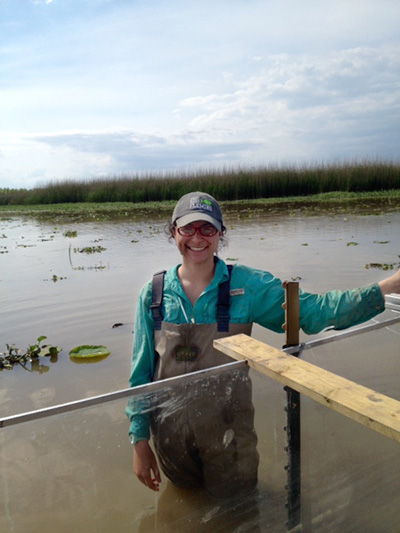Over the River and Through the Marsh
CEE Student Chooses LSU for Graduate Studies
03-05-18
BATON ROUGE - Wearing chest waders, sinking in mud and exploring the Louisiana marsh is not everyone’s idea of heaven. For Kathleen Eubanks, however, there is nothing else she would rather do.
Eubanks, an LSU student working on her Master of Science in Coastal and Ecological Engineering, spends her days studying problems faced by coastal Louisiana. She hopes her work not only contributes to helping the affected communities, but also inspires others to join the crusade.
Born and raised in New Orleans, Eubanks has “always enjoyed technical things.” As most young adults do, she bounced between ideas of what she wanted to be, going from a teacher or nurse to an architect or doctor. Then she realized none of those were quite the right fit.
“I always knew I loved science and math and I wanted to help people,” she said. “I figured that meant I would be a doctor, but once I realized a passion for science and serving others could be utilized in engineering and coastal science, I changed course.”
Eubanks’ love for the marsh and coastal restoration really began when she worked on a salt marsh restoration project as an undergraduate majoring in bioenvironmental sciences at Texas A&M University, where she also received a minor in STEM education. Her role in the project consisted of sampling and observing how the ecosystem responded after an oyster barrier had been dug out, reconnecting the marsh with the adjacent bay and restoring the hydrology.
“I fell in love with the marsh there,” she said. “I didn’t want to leave. I just wanted to be a muddy scientist. I felt at home.”
Her move to LSU was thanks to one chance encounter with LSU Professor and Louisiana Sea Grant Executive Director Robert Twilley.
“I had heard about Dr. Twilley at LSU and his studies in Wax Lake Delta,” Eubanks said. “I had read some of his work and then happened to meet him at a conference. He suggested I visit LSU and chat with him and Dr. Clint Willson in (the Department of) Civil Engineering. I originally wanted to get my master’s in oceanography and coastal science, but they told me about the coastal and ecological engineering program and how it was designed to bridge the gap between ecology and engineering.
“They’re so intertwined in these coastal restoration projects that you can’t have one without the other. It’s all about using engineering principles to describe and design these ecosystem processes, and that got me. I told them, ‘Sign me up. Let’s do this.’”
Soon after starting her graduate studies, Eubanks spent part of last summer as a student research fellow at the 2017 National Oceanic and Atmospheric Administration (NOAA) National Water Center Innovators Program in Tuscaloosa, Ala. She was one of 32 fellows representing 25 universities who worked on group projects with faculty advisors and other students. In fact, she worked with students from Pennsylvania State University and Iowa State University on a project aimed at using public input to create better online flood mapping tools.
“It was an excellent opportunity to work with professors, graduate students, and professionals who each have a unique wealth of knowledge to share,” Eubanks said. “We were encouraged to look at problems, in this case flooding, from different perspectives—that of engineers, hydrologists, emergency managers, data and visualization scientists, and even that of a mayor whose town had faced natural disaster. The program encouraged me to push myself to learn more about topics I wasn't as strong in while also providing me contact with folks from whom I could learn these things.”
Eubanks now spends her days at LSU as a graduate student and research assistant studying river modeling and flood hydrology under her advisors, Wilson and Twilley. She is currently working on a grant with the Coastal Sustainability Studio called “Inland from the Coast” that studies communities affected by flooding. It is specifically focused on a general move inland to avoid coastal flooding and then being faced with riverine flooding, as was the case for many affected by the August 2016 floods in Baton Rouge. Having been impacted by the flood herself, Eubanks hopes that her research will contribute to a better description of the hydrology of the Amite River Basin and serve the people and communities that call it home.
“There are moments when you get a little down because it’s such an undertaking and you see the direct impact that flooding and land loss have on people’s lives,” she said. “It’s heavy stuff. Is this realistic? What impact am I going to make? It’s in these moments of doubt that I remind myself of my favorite quote by Mother Theresa, ‘We can do great things, only small things with great love.’ I’m not going to save the coast on my own but maybe my research, hard work, vision or enthusiasm will inspire someone to do this work as well.”
Eubanks says her dream job would include working in the field like she has done on some of Twilley’s projects.
“Waking up at 4 a.m. isn’t fun, but once you get out there, it’s like, ‘This! This is what I do this for,’” she said with a huge smile on her face. “I love being in a boat and in the marsh up to my neck in mud. The plants, the animals, it’s stunning. I love it out there.”
By Libby Haydel
Communications Specialist
ehaydel1@lsu.edu
225-578-4840